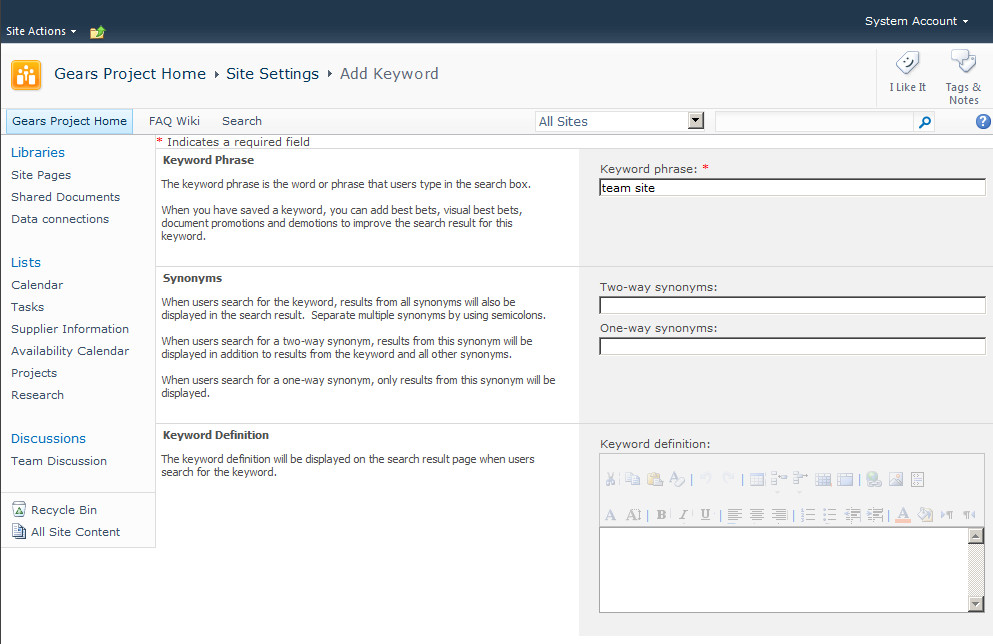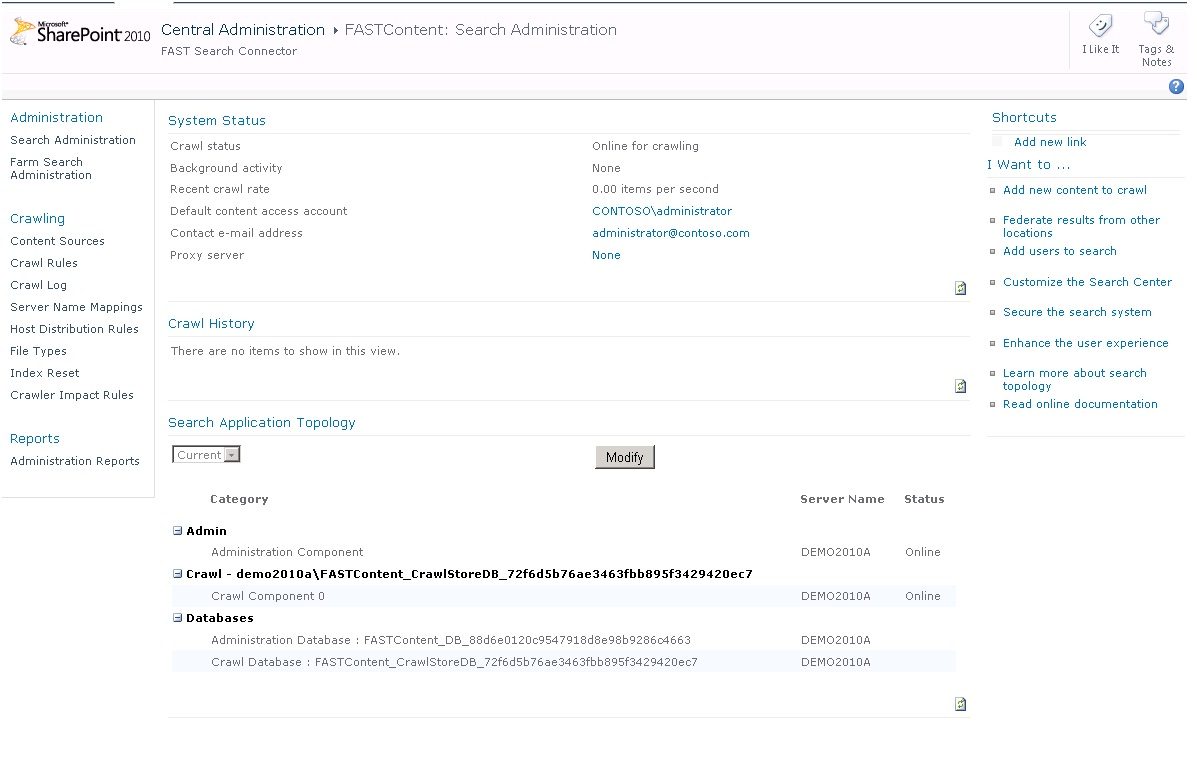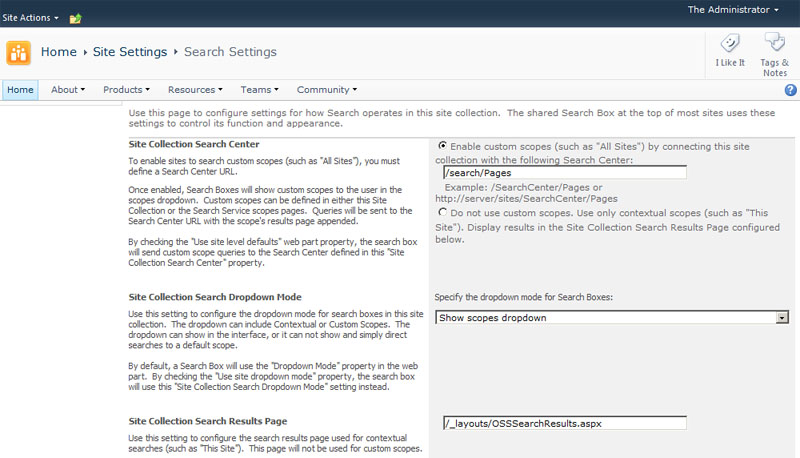Administration Options
Microsoft SharePoint 2010 Search provides business users with a highly efficient and customised intranet search capability. Not only does it index all of your enterprise data on SharePoint 2010 server, but it also enables you to search documents, file share, and other data sources and repositories. Server administrators can use SharePoint administrative options to deploy, configure, and administer all SharePoint 2010 services. As an administrator, you can administrate SharePoint Search at two levels; Site Level and Service application level.
In my next post I will cover the differences between SharePoint 2010 Search and SharePoint 2013 Search.
Site level
At the site level, you can manage search settings for the specific site collection under the site settings page. As a site collection administrator, you have full rights to manage all of the sites within a site collection. A site collection is a group of web sites that have the same owner and share the same administration settings. It is made up of one top-level website and one or more sub sites.
The two administrative options available at the site level are;
- Search settings
You click the Search Settings administrative option to open the Search Settings page. This page enables you to configure the search settings for a site collection. It allows you to specify the Search Centre that should be used for a particular site collection.
A Search Centre is an exclusive SharePoint web template that is customised for searching. It is preconfigured with a search page, a search results page, and a special master page, which presents the search results in an enlarged screen space.
Using the Search Settings page, you can enable sites to search within custom scopes. You do this by defining a Search Centre URL. Once you define a Search Centre, the custom scopes are presented to users in the scopes drop-down menu. For most templates, the Search Centre is not provided by default, and so you will need to set up a Search Centre.
You can also use the Search Settings page to configure the drop-down mode for search boxes in a site collection. The drop-down mode can comprise either a custom or contextual scope. You can configure the drop-down mode settings to either show or hide the drop-down box in the interface. In instances where the drop-down box is hidden, the Search Settings page can direct searches to any default scope.
Also, there might be instances during which a Search Centre may not be defined. In such cases, the Search Settings page indicates the appropriate search results page that you need to use. Additionally, this setting helps you to configure the search results page for contextual searches.
Figure 1: SharePoint 2010 Search – Set-up
- Search keywords
In addition to Search settings, you can use the Search keywords option at the site collection level. This option refines your search experience by pulling out the exact results you’re searching for. It does this by adding keywords to the search query and then associate best bet with the keyword. On the Add Keyword page, you specify the search term in the Keyword phrase field and associate it with the best bet. The Add Best Bet dialog box allows you to add keyword to your search. To refine your search, you can set up keywords and you associate definitions and best bets, a link to the content that is most commonly searched for.

Service Application Level
At the service application level, you manage settings that affect all site collections that are associated with a particular service application. Service application can be a single service or a set of services and can be shared across farms or within a farm. You can also administrate SharePoint 2010 Search at the service application level, and manage various settings at this level.
At the service application level, you can perform the following administrative tasks;
Crawling is a process where the crawl component acts as your indexer. The indexer will directly connect to your content and then send the content to the server. It then generates the index and extracts the appropriate metadata. When you configure the Service Application to perform crawling, you can choose from a number of crawl settings. Some of these crawl settings helps you to;
- define the source that SharePoint will crawl
You can use the Content Sources crawl settings to define the content source that should be crawled. SharePoint 2010 supports six different types of content sources. By default, SharePoint creates a content source that includes all of the SharePoint web applications that are already present in the SharePoint farm. Using the Content Sources page, you can add a new content source, and manage existing sources. You can also manage crawls from this page.
- set the type of crawl
You can set the type of crawl you require by using crawl settings. SharePoint 2010 supports two types of crawls – full crawl and incremental crawl. A full crawl covers all of the content that is available in a content source. An incremental crawl crawls only the content that has changed since the last crawl was performed. It keeps track of any changes by referencing the change log. Incremental crawls are much faster than full crawls.
- Set a crawl schedule, and
In SharePoint, you can set a crawl schedule to establish the times at which a content source can be crawled, how often it should be crawled, and the type of crawl that should be performed. You can set a crawl schedule whenever you create or edit a content source. You can also schedule full and incremental types of crawls. To ease the strain on the server, you can set your full crawls to run during low-usage time for the sites. Alternatively, incremental crawls can be run frequently.
- Set up server name mappings
You can set up server name mappings to prevent users from viewing the actual location of a searched file for security reasons. For example, you can set up a server name mapping to avoid displaying the actual location of a shared drive that stores the files searched by users.

You can also use server name mappings when the search results display a file location that may have access problems. Using the Crawling options, you can;
- optimise searching within SharePoint Farms
- include different file types in SharePoint’s search index
- reset the search index, and
- manage the impact of search on the server
- querying
- reporting of the search status
Apart from crawling, the Search Administration page enables you to manage settings for handling search queries. It also allows you to display the search results the way you want to.
To configure those settings, you can use the Queries and Results section which help in fine-tuning the user search experience. These settings allow you to;
- set authoritative pages in a site
You can refine the end user search experience by setting these commonly relevant pages in the site as the most authoritative. You can have multiple authoritative pages, and assign ranks such as the most authoritative, second-most authoritative, and so on.
- incorporate federated locations into search results pages
These provide users with better search results that are loaded with extra information, which they may not get during a standard search.
When you set up federated locations, you enable the query raised by a user to run on many other alternative sources, in addition to the standard SharePoint search index. This gives them richer results with more information. You can include Internet search engine results, databases, and search scopes defined for SharePoint into the search results.
- associate metadata with content
If you need to filter the search results, for example by a particular document type, you use the settings called Metadata Properties. This setting contains the mapping properties set up for each bit of metadata.
- set scopes to narrow a search, and
At times, when performing a query, you may need to restrict your search results to a limited section of the overall search index content. For instance, you may need to access a specific content source or web address. You can do this by setting scopes for the required data. While setting up a scope, you first need to give it a name and then define the type of rules that will apply to the scope.
- remove content from search results
Sometimes, for security reasons, you may want to prevent specific content from appearing in the search results as soon as possible. This setting immediately removes the specified URL from the search results and adds the address to the Crawl Rules, to exclude that content from future crawls.
In addition to crawling and querying data, you can also perform reporting. Several different types of reports are available to an administrator. There are two types of reports that help you review the performance of the search function:
- reports that track the performance of Search and
You can use the Administration Reports option to access reports from the Administrative Report Library. This Library contains several search-related reports, which you can access to track the performance of Search.
You can click the required report and view the generated graph. You can use this data to monitor the time it takes for crawling each content source, how fast it is crawling… You can also analyse the time taken for the queries to return results.
- reports that show the total number of queries performed on the site
You use the Web Analytics Reports option to access reports that show the total number of queries performed on the site, and the average number of queries per day. These reports contain graphical data relating to the number of queries over a period of time and how often they are performed.
You can view the queries that give you zero results by using the No Question Results report.
Summary
SharePoint 2010 Search provides two levels to administrate Search – site and service application. The administrative options at the site level are Search settings and Search keywords. A search setting enables you to decide which Search Centre to use and how drop-down boxes should behave for the site collection. Search keywords enable you to add keywords and associate items with best bets.
The key administrative options available at the service application level are; crawling, queries, and reports. Crawling allows you to define content sources, set the crawl type, and reset the search index, and so on. Queries let you configure search settings to manage how search results are displayed. Additionally, administrators can use Administration and Web Analytics reports to review the performance of the search function.

